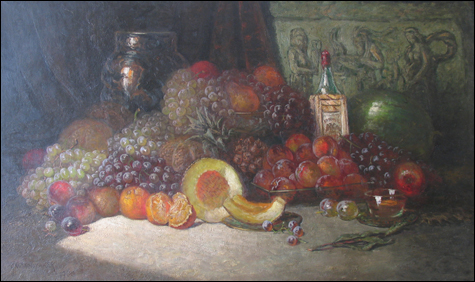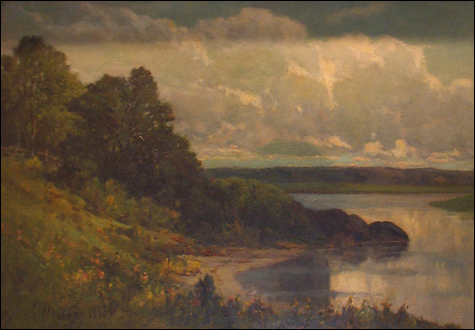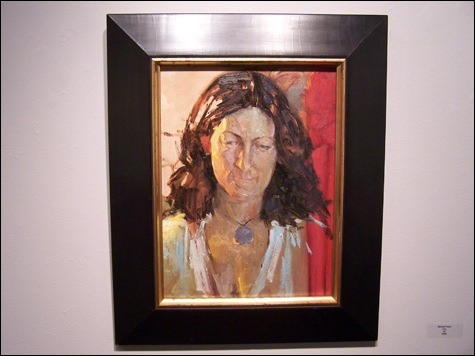
STILL LIFE Whitaker's "Fruit with Frieze." |
One of the landmark tales of Rhode Island art is the story of how Edward Bannister won the oil painting prize at the 1876 Philadelphia Centennial Exposition. When the African-American artist tried to collect his certificate, racist white organizers tried to rescind the award, but finally gave it to him under pressure from other competing artists. Bannister went on to be one of the 16 founders of the Providence Art Club in 1880, a trustee of the Rhode Island School of Design, and today one of his paintings is in the collection of the White House — though his work remains not well-known.
In “Our Founders,” at the Providence Art Club (11 Thomas Street, through October 8), you come face to face with that prize certificate, now freckled with age, and you can feel both the triumph and the insult of the episode.
The show is a survey 105 paintings by Bannister (1828-1901) and fellow Art Club founder George Whitaker (1840-1916) from the 1860s to 1910s. The show is primarily landscapes done in the earthy, romantic style of 19th-century French Barbizon landscape paintings.

PASTORAL LIVING Bannister's "The Palmer River." |
In one small canvas, Bannister depicts a man leading a few cows along a lane as sheep graze on a grassy hill below and gray clouds billow in the distance. Bannister’s best works are often dreams of pastoral living, animated by dramatic lighting — in this case, a strip of sunlight spotlighting the herder and his cattle.
Also noteworthy here is Bannister’s Hay Gatherers (1893), with women walking or working a field as people haul hay onto an overflowing cart in the distance. Bannister and Whitaker’s canvases usually look sharp from across the room but can seem muddled up close. That’s not the case here. It’s painted with a fine soft focus, but what sets it apart is it’s the only painting in the show depicting black people. It makes you wonder about Bannister’s racial balancing act as he strove to make a name for himself in the white-dominated art world.
Whitaker has a more expressionist style, frequently rendered in crusty impastos — that could be inspired by Turner or Courbet, but most likely come from Monet’s Impressionism. His landscapes can get bombastic, with careless color and brushstrokes. His still-lifes of grapes, oranges, melons, and wine bottles often lack the juicy shine of the fruit. But at his best, like his 1893 painting Forest, of a cart path running down to a thick autumn wood, Whitaker fills his landscapes with a lush fairy tale fecundity.
Meanwhile, Bannister Gallery — named for Edward — at Rhode Island College (600 Mount Pleasant Avenue, Providence) offers its "Annual Faculty Exhibition: New Mastery" (through September 30). What stands out here is the strength of the painting by RIC teachers.

EVOCATIVE Peery’s "Kim." |
Lisa Russell continues to make sharp small abstract paintings built from lots of carefully arranged, deliciously creamy vertical strokes that form a sort of patchwork rhythm of green, ochre, white, and black. Richard Whitten offers a tight — too tight? — trompe l’oeil painting of a spinning carnival-type game contraption framed in an arched doorway, with a ball rolling around on top seemingly in defiance of gravity. Michael Peery’s loose brushy realist portrait of Kim, built of lots of short dashed strokes, gets its mood from its evocative sense of gold light. Richard Collins shows four small kinetic abstractions that seem indebted to Franz Kline. And in Stephen Fisher’s Autumn Tangle, a black-and-white pencil drawing of a tangle of trees heading down to a river, which is so incredibly detailed that it seems at first glance to be a photo. It’s a stellar showcase of old school media.